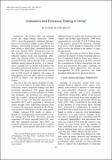Institutions and Emissions Trading in China
Author(s)
Karplus, Valerie Jean
Downloadpandp.20181030.pdf (464.7Kb)
PUBLISHER_POLICY
Publisher Policy
Article is made available in accordance with the publisher's policy and may be subject to US copyright law. Please refer to the publisher's site for terms of use.
Terms of use
Metadata
Show full item recordAbstract
Institutions—the formal rules and informal norms that shape human interaction ( North 1991 )—have the potential to influence the oper - ation of an emissions trading system ( ETS ). For instance, preexisting economic regulation has been shown to affect firms’ abatement decisions and costs (Fowlie 2010). Transaction costs can also interfere with cost-effective operation by reducing trading levels and increasing abatement costs (Stavins 1995). As China develops a national ETS for carbon dioxide (CO₂) covering multiple energy-intensive sectors, it is important to consider how its design will interact with prevailing institutional features of the country’s economy. This paper focuses specifically on the role of state control of industry, one source of heterogeneity that will affect efforts to establish an ETS in China’s vast and diverse economic system.
Date issued
2018Department
Massachusetts Institute of Technology. Department of Civil and Environmental Engineering; Massachusetts Institute of Technology. Institute for Data, Systems, and Society; MIT Energy Initiative; Sloan School of ManagementJournal
AEA Papers and Proceedings
Publisher
American Economic Association
Citation
Karplus, Valerie Jean. “Institutions and Emissions Trading in China.” AEA Papers and Proceedings 108 (2018): 468–72.
Version: Final published version
ISSN
2574-0768